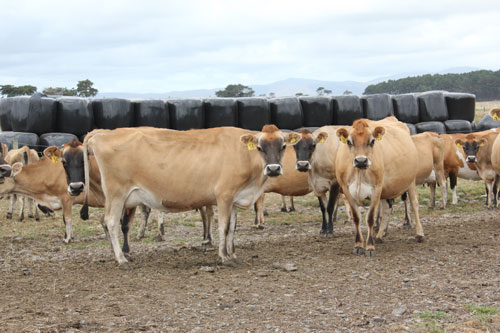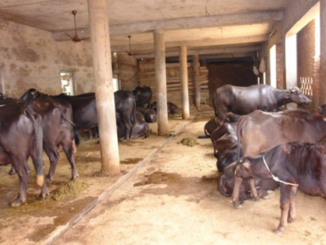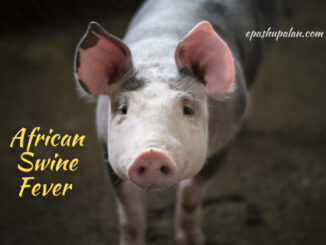Introduction
Livestock refers to any stock which is used for the production of items of commercial importance. It includes in a broad sense, all animals, birds, and other living creatures used for the production of items, that are useful for man. In narrow sense, it includes generally farm animals. One important farm animal to which nation’s economy is completely dependent is Cattle. There are innumerable number of diseases affecting cattle. This includes both bacterial and viral diseases. Some of the commonly occurring infections are given below.
1. Foot and mouth disease
It is commonly called komari in tamil.
Etiology: Family: Picronaviridae, Genera: Aphtho virus, There are 7 serotypes (O, A,C, Asia 1, SAT 1, SAT 2, SAT 3), out of which O is prevalent India.
Pathogenesis: The virus enters the host mainly by inhalation or ingestion. Primary replication occurs in the epithelium of upper respiratory tract or alimentary canal and primary viraemia occurs which initiates fever . Further viral replication occurs in the lymph nodes, mammary gland , interdigital space , muzzle and it is characterized by vesicle formation. These vesicles are formed within 4 days of infection. These vesicles gets eroded and leads to ulcer and causes foot lameness.
Clinical signs
- Vesicles in mucosa
- Decline in the Milk production
- Reduced feed intake
- lameness
- Abortion
- Lack of heat tolerance
Prevention and control
- Control of livestock movement
- Quarantine the animal in non endemic area
- Inactivated vaccine in endemic areas. Calves should be vaccinated at 4 months of age and revaccination at every 6 months.

2. Hemorrhagic septicemia
A Contagious cattle disease caused Pasturella multocida, a Gram negative cocci in the family Pasturellaceae.
Pathogenesis: The organism occurs in the upper respiratory tract of various species. It is mainly transmitted by inhalation. In acute form, it results in multiple haemorrhage on the serous membrane and edema of the subcutaneous tissues in the region of throat and brisket region. It also causes gastroenteritis with enlargement of mesenteric lymph node
Clinical sign
- Fever, salivation, dullness
- Oedema in the brisket region
- Diarrhoea
- Nasal discharge
Prevention and control: Prophylactic vaccination (formalised P.multocida P52 strain) should be carried out annually about a month before the onset of monsoon. It gives protection for 6 months to 1 year.
3. Brucellosis
It is a zoonotic infection caused by the bacterial genus Brucella coming under the family Brucellaceae. They are obligate parasite and are located intracellularly.
Pathogenesis: Brucellosis is the main cause of abortion, sterility and decreased milk production in cattle. It is transmitted mainly by ingestion and these organism are phagocytosed by the cell and multiply inside the cell . Sooner ,it reaches lymph node followed by blood stream . It has predilection towards reproductive tract of male and female . It causes abortion after 6 months in cattle .
Clinical signs
- Abortion, sterility
- Still birth
- Lameness, spondylitis, orchitis
- Retention of placenta
Prevention and control: The effective control of brucellosis depends upon the identification and elimination of infected animals. Strain 19 vaccine is widely used in cattle and has enabled the incidence of abortions to be greatly reduced in India. It is administered to female cattle upto 5 months of age.
4. Anthrax
It is a serious infectious disease caused by Bacillus anthracis, a gram positive rod comes under the family Bacillaceae.
Pathogenesis
Anthrax is usually acquired through breaks in the skin or mucous membrane to which the spores of B. anthracis gain access. Spores remain viable for more than 50 years. It germinates inside the host to vegetative cells and develops into systemic infection. In septicemic form, it causes sudden death and in subacute form, it causes oedematous swelling in pharyngeal tissuse and reginal lymphadenitis
Clinical signs
- Bloat
- Sudden death
- Bleeding from natural orifices
- Absence of rigor mortis
Prevention and control
- Animals died of anthrax should be disposed properly by burning or burying to prevent contamination of environment.
- Use of vaccination (Sterne spore vaccine) is of great value in the control of disease. It gives protection for one year.
- anthracis is susceptible to penicillin , thereby it can be treated in the early stages .
5. Tuberculosis
Bovine tuberculosis is the chronic disease of cattle caused by the bacteria Mycobacterium bovis and Mycobacterium tuberculosis coming under the family Mycobacteriaceae.
Pathogenesis: The organism transmits via ingestion and inhalation. It reaches local lymph nodes where it multiplies and enters thoracic duct . Activated macrophages kill the bacteria. But the virulence factors of the bacteria causes aggregation of macrophages and forms Tubercle. This is characterized by caseous necrosis surrounded by the zone of epitheloid cell and peripheral zone of lymphocyte and fibroblast. Calcification also occurs in necrosed area. Tubercle normally presents in lymph node, lungs and pleura area.
Clinical signs
- Dry cough
- Dyspnea
- Weight loss
- Fever
Prevention and control
- Treatment is impractical
- Tuberculin testing followed by isolation and slaughter is the best method to control the disease
6. Johne’s disease
A chronic contagious enteritis causing disease caused by mycobacterium paratuberculosis .
Pathogenesis: Organism shed in faeces, milk and remain viable upto 1 year in the environment. These are transmitted mainly through ingestion route. The organism is engulfed by the macrophages and replicates inside the macrophages( mostly in peyer’s patches). It triggers immune mediated granulomatous reaction and followed by accumulation of lymphocyte and fibroblast in lamina propria and submucosa of intestine. This causes reduced absorption of nutrients and water leading to diarrhoea.
Clinical signs
- Diarrhoea
- Progressive weight loss
- Emaciation
- Death
Prevention and control:
- Suspected animals should be isolated from the herd
- Culling of animal if the animal is tested positive
- Inactivated and live vaccines are available
Conclusion
These diseases are of economic importance to farmers as they raise cattle for the milk and meat purpose. Controlling these diseases to cattle is of immense importance to prevent the loss of economy of the nation. Zoonotic potentiality is also present in such diseases, thereby it may spread to the person who attends the infected animal. Hence, the doctors and the farmers should be cautious enough to mitigate the transmission rate and also renders them safe in handling animals.






1 Trackback / Pingback